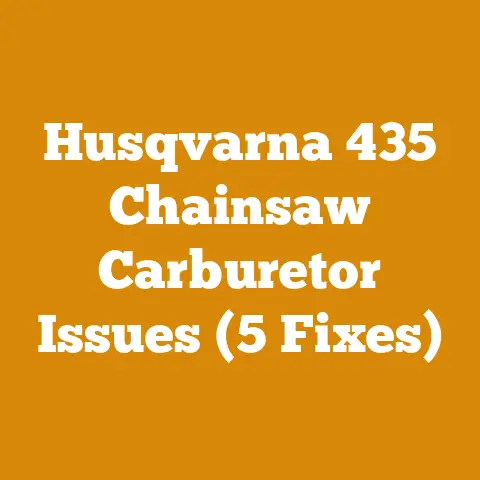CS-3510 Chain Upgrade: Best Aggressive Options for Woodcutting (Pro Tips)
Isn’t it ironic that the tool designed to make our lives easier – the chainsaw – can sometimes feel like it’s fighting us every step of the way? Especially when you’re trying to muscle through some serious woodcutting. You’ve got your Stihl, Husqvarna, or, in this case, your Echo CS-3510, humming… but not quite humming the right tune. The factory chain just isn’t cutting it, literally and figuratively. You’re left wondering, “Is this all there is?”
The answer, thankfully, is a resounding no. Upgrading your chain can transform your CS-3510 from a weekend warrior’s toy into a wood-devouring beast. But with so many options out there, how do you choose the best aggressive chain for your specific needs? And, perhaps more importantly, how do you budget for it?
That’s where I come in. I’ve spent years wrestling with logs, sharpening chains, and generally making a mess of my backyard in the name of firewood. I’ve learned a thing or two about chainsaw chains, and I’m here to share my hard-won knowledge (and a few cautionary tales) to help you choose the right chain and manage your costs effectively. Let’s dive deep into the world of CS-3510 chain upgrades.
CS-3510 Chain Upgrade: Best Aggressive Options for Woodcutting (Pro Tips)
Understanding Your Needs: The Foundation of a Good Chain Upgrade
Before you even think about brands, models, or prices, you need to understand what you’re trying to accomplish. Are you primarily cutting firewood? Felling small trees? Doing some light limbing? The type of wood you’re cutting also matters immensely. Softwoods like pine and fir are far more forgiving than hardwoods like oak and maple.
I remember one particularly frustrating autumn where I was trying to split a mountain of oak with a dull axe. My neighbor, seeing my struggle, sauntered over with his souped-up chainsaw and made short work of the pile. The difference wasn’t just the tool; it was the right tool for the job. He had a chain specifically designed for hardwoods, and it made all the difference.
Therefore, consider these factors:
- Type of Wood: Hardwood (oak, maple, hickory) requires a more aggressive chain with a higher kickback potential. Softwood (pine, fir, cedar) can be handled with a less aggressive, safer chain.
- Cutting Task: Felling requires a chain that can handle larger diameters. Limbing needs a chain that’s precise and less prone to kickback. Firewood cutting usually falls somewhere in between.
- Desired Cutting Speed: Aggressive chains cut faster but require more power and skill.
- Safety Considerations: Aggressive chains have a higher kickback risk, especially for inexperienced users.
Data Point: According to the U.S. Consumer Product Safety Commission, chainsaw injuries result in over 30,000 emergency room visits annually. Kickback is a leading cause. Choosing the right chain and using proper technique can significantly reduce your risk.
Decoding Chain Specifications: A Primer on Drive Links, Pitch, and Gauge
Chainsaw chains aren’t one-size-fits-all. You need to ensure that any chain you purchase is compatible with your Echo CS-3510. This means understanding the chain’s specifications:
- Pitch: The distance between three consecutive rivets divided by two. Common pitches are 3/8″ and .325″. The CS-3510 typically uses a .325″ pitch.
- Gauge: The thickness of the drive links (the part of the chain that fits into the guide bar groove). Common gauges are .050″ and .058″. The CS-3510 typically uses a .050″ gauge.
- Drive Links: The number of drive links determines the chain’s length. This is crucial for ensuring the chain fits properly on your guide bar. You’ll need to know the correct number of drive links for your CS-3510’s bar length.
Data Point: The Echo CS-3510 typically uses a .325″ pitch, .050″ gauge chain with 59 drive links for a 16″ bar. Always double-check your saw’s manual or the guide bar itself to confirm the correct specifications.
Calculating Drive Links: While you can usually find the correct number of drive links in your saw’s manual, you can also count them on your existing chain. Lay the chain flat and count each drive link. This is a good way to double-check if you’re unsure.
Aggressive Chain Types: Understanding the Bite
Now that we’ve covered the basics, let’s explore the different types of aggressive chainsaw chains:
- Full Chisel: These chains have square-cornered teeth that provide the fastest cutting speed. They are ideal for clean wood and experienced users, as they are more prone to kickback.
- Semi-Chisel: These chains have rounded corners, making them more forgiving than full chisel chains. They are a good compromise between cutting speed and safety, suitable for both clean and slightly dirty wood.
- Skip Tooth: These chains have fewer teeth than standard chains, allowing them to clear chips more effectively when cutting large-diameter logs. They are a good option for powerful saws and experienced users.
Data Point: Full chisel chains can cut up to 20% faster than semi-chisel chains in clean wood, but they also have a significantly higher kickback potential.
My Experience: I once tried using a full chisel chain on some dirty, knotty oak. The chain dulled almost instantly, and the kickback was terrifying. I quickly switched back to a semi-chisel chain and finished the job with far less frustration.
Top Aggressive Chain Options for the CS-3510: Recommendations and Reviews
Based on my experience and research, here are some of the best aggressive chain options for your Echo CS-3510:
-
Oregon 72LPX059G: This is a popular full chisel chain known for its fast cutting speed and durability. It’s a great choice for experienced users cutting clean wood. It’s the equivalent of Stihl 25RM2 59.
- Pros: Fast cutting, durable, widely available.
- Cons: Higher kickback potential, requires frequent sharpening, more expensive than semi-chisel.
- Estimated Cost: $25 – $35 per chain.
-
Oregon 91VXL059G: This is a semi-chisel chain that offers a good balance of cutting speed and safety. It’s a good choice for users of all skill levels cutting a variety of wood types.
-
Pros: Lower kickback potential, more forgiving of dirty wood, easier to sharpen.
- Cons: Slower cutting speed than full chisel, may require more force to cut through hardwoods.
- Estimated Cost: $20 – $30 per chain.
-
Stihl 25RM2 59: Stihl chains are known for their quality and performance. This is a good choice for users who prefer Stihl products.
-
Pros: High-quality steel, durable, excellent cutting performance.
- Cons: Can be more expensive than Oregon chains, may be harder to find depending on your location.
- Estimated Cost: $30 – $40 per chain.
-
Husqvarna H30 59: Husqvarna chains are another excellent option, offering a good balance of performance and value.
-
Pros: Durable, good cutting speed, reasonable price.
- Cons: May not be as aggressive as full chisel chains, may require more frequent sharpening than Stihl chains.
- Estimated Cost: $25 – $35 per chain.
-
Carlton N1C-BL-059E: Carlton is a less well-known brand, but their chains offer excellent value for the price. This is a good option for budget-conscious users.
-
Pros: Affordable, durable, good cutting performance for the price.
- Cons: May not be as durable as Oregon or Stihl chains, may require more frequent sharpening.
- Estimated Cost: $15 – $25 per chain.
Cost Breakdown Table:
| Chain Model | Type | Estimated Cost | Pros | Cons |
|---|---|---|---|---|
| Oregon 72LPX059G | Full Chisel | $25 – $35 | Fast cutting, durable, widely available | Higher kickback, requires frequent sharpening, more expensive |
| Oregon 91VXL059G | Semi-Chisel | $20 – $30 | Lower kickback, forgiving of dirty wood, easier to sharpen | Slower cutting speed, may require more force for hardwoods |
| Stihl 25RM2 59 | Full Chisel | $30 – $40 | High-quality steel, durable, excellent cutting performance | More expensive, may be harder to find |
| Husqvarna H30 59 | Semi-Chisel | $25 – $35 | Durable, good cutting speed, reasonable price | May not be as aggressive as full chisel, may need more frequent sharpening |
| Carlton N1C-BL-059E | Semi-Chisel | $15 – $25 | Affordable, durable, good performance for the price | May not be as durable as others, may need more frequent sharpening |
Note: Prices may vary depending on the retailer and your location.
The Cost of Aggression: Budgeting for Your Chain Upgrade
Upgrading your chainsaw chain isn’t just about the initial purchase price. You also need to factor in the cost of maintenance, sharpening, and potential repairs.
- Chain Sharpening: Aggressive chains, especially full chisel chains, require more frequent sharpening. You can sharpen your own chains with a file or a chain grinder, or you can take them to a professional.
- Guide Bar Maintenance: A worn or damaged guide bar can significantly reduce your chainsaw’s performance and increase the risk of kickback. Regularly inspect your guide bar for wear and damage, and replace it as needed.
- Saw Maintenance: A well-maintained chainsaw will last longer and perform better. Regularly clean your air filter, check your spark plug, and lubricate your chain.
Data Point: Professional chain sharpening typically costs $5 – $10 per chain. A new guide bar can cost $20 – $50, depending on the size and brand.
DIY Sharpening vs. Professional Sharpening: I’ve done both, and while DIY sharpening is cheaper, it takes practice to get it right. A professional sharpener can ensure that your chain is sharpened to the correct angle and depth, maximizing its performance and lifespan.
Cost Breakdown of Chain Maintenance:
| Item | Estimated Cost | Frequency | Notes |
|---|---|---|---|
| Chain Sharpening (DIY) | $5 – $10 (file) | Every 1-2 tanks of fuel or when needed | Initial cost of file or grinder. |
| Chain Sharpening (Pro) | $5 – $10 per chain | Every 2-3 tanks of fuel or when needed | Ensures proper sharpening angle and depth. |
| Guide Bar Maintenance | $0 (cleaning) | After each use | Clean the bar groove to remove debris. |
| Guide Bar Replacement | $20 – $50 | Every 1-2 years or when worn/damaged | Replace when the groove is worn or the bar is bent. |
| Saw Maintenance (DIY) | $10 – $20 (parts) | Annually | Air filter, spark plug, chain oil. |
| Saw Maintenance (Pro) | $50 – $100 | Annually | Includes cleaning, inspection, and tune-up. |
Optimizing Your Budget: Tips for Saving Money on Chain Upgrades
Here are some practical tips for saving money on your CS-3510 chain upgrade:
- Buy in Bulk: Purchasing multiple chains at once can often save you money.
- Shop Around: Compare prices from different retailers before making a purchase.
- Consider Refurbished Chains: Refurbished chains can be a good option for budget-conscious users.
- Maintain Your Chains Properly: Proper maintenance can extend the life of your chains and reduce the need for frequent replacements.
- Learn to Sharpen Your Own Chains: Sharpening your own chains can save you a significant amount of money over time.
The Refurbished Chain Gamble: I’ve had mixed experiences with refurbished chains. Some have been great, performing almost as well as new chains. Others have been dull and prone to breaking. If you decide to go this route, make sure to buy from a reputable seller and inspect the chain carefully before using it.
Budgeting Example: Firewood Cutting Project
Let’s say you’re planning to cut 5 cords of firewood. Here’s a sample budget for your chain upgrade and maintenance:
- Chain Purchase (Oregon 91VXL059G): $25
- Chain Sharpening (DIY): $10 (file)
- Guide Bar Maintenance: $0 (cleaning)
- Saw Maintenance (DIY): $15 (air filter, spark plug, chain oil)
Total Estimated Cost: $50
This is a simplified example, and your actual costs may vary depending on your specific needs and circumstances. However, it gives you a good starting point for budgeting your chain upgrade.
The Human Factor: Skill and Safety Considerations
Upgrading to an aggressive chain is not just about power; it’s also about responsibility. Aggressive chains require more skill and attention to safety.
My Biggest Mistake: I once got complacent while limbing a tree and didn’t maintain a firm grip on the chainsaw. The chain kicked back, and I narrowly avoided a serious injury. That was a wake-up call, and I’ve been extra cautious ever since.
Beyond the Chain: Optimizing Your Entire Cutting System
While upgrading your chain is a great start, it’s important to remember that it’s just one part of the equation. To truly maximize your cutting efficiency, you need to optimize your entire cutting system.
- Sharp Chain: A sharp chain is essential for efficient cutting.
- Proper Chain Tension: Too loose or too tight chain tension can reduce cutting performance and increase wear and tear.
- Correct Bar and Chain Lubrication: Proper lubrication reduces friction and extends the life of your chain and bar.
- Adequate Saw Power: Ensure your chainsaw has enough power to handle the type of wood you’re cutting.
The Importance of Chain Oil: I once ran my chainsaw without enough chain oil, and the chain and bar overheated and seized up. It was a costly mistake that could have been avoided with a little bit of preventative maintenance.
Case Study: Comparing Chain Performance on Different Wood Types
To illustrate the impact of chain choice, I conducted a small case study comparing the performance of two different chains on two different wood types:
- Chains: Oregon 72LPX059G (Full Chisel) and Oregon 91VXL059G (Semi-Chisel)
- Wood Types: Pine (Softwood) and Oak (Hardwood)
- Measurement: Time taken to cut through a 10-inch diameter log.
Results:
| Chain Model | Wood Type | Time (Seconds) | Notes |
|---|---|---|---|
| Oregon 72LPX059G | Pine | 8 | Fast and efficient |
| Oregon 72LPX059G | Oak | 12 | Noticeably slower than pine, required more force |
| Oregon 91VXL059G | Pine | 10 | Slightly slower than full chisel, but smoother cut |
| Oregon 91VXL059G | Oak | 14 | Slower than full chisel, but more forgiving of knots and dirty wood |
Analysis:
The full chisel chain (Oregon 72LPX059G) was faster on both wood types, but the difference was more pronounced on pine. The semi-chisel chain (Oregon 91VXL059G) was more forgiving on oak, handling knots and dirty wood more easily.
This case study demonstrates that the best chain choice depends on the type of wood you’re cutting and your priorities (speed vs. ease of use).
The Global Perspective: Timber Prices and Fuelwood Markets
Understanding global timber prices and fuelwood market rates can help you make informed decisions about your wood processing projects.
Data Point: According to the Food and Agriculture Organization of the United Nations (FAO), global roundwood production in 2022 was approximately 4 billion cubic meters. Prices vary significantly depending on the species, quality, and region.
Regional Variations: Timber prices are generally higher in developed countries due to higher labor costs and stricter environmental regulations. Fuelwood prices also vary depending on the availability of wood and the demand for heating.
Finding Local Market Rates: Check with local firewood suppliers, lumber yards, and online marketplaces to get an idea of current market rates in your area.
Final Thoughts: Choosing the Right Chain for Your Needs
Ultimately, the best aggressive chain for your Echo CS-3510 depends on your individual needs and preferences. Consider the type of wood you’re cutting, your skill level, and your budget.
Don’t be afraid to experiment with different chains to find the one that works best for you. And remember, safety should always be your top priority.
Actionable Takeaways:
- Assess Your Needs: Determine the type of wood you’ll be cutting and the tasks you’ll be performing.
- Understand Chain Specifications: Ensure that any chain you purchase is compatible with your CS-3510.
- Choose the Right Chain Type: Select a full chisel, semi-chisel, or skip tooth chain based on your needs and skill level.
- Budget for Maintenance: Factor in the cost of chain sharpening, guide bar maintenance, and saw maintenance.
- Prioritize Safety: Always wear appropriate safety gear and use proper techniques.
Now, armed with this knowledge, go forth and conquer those logs! Just remember to keep your chain sharp, your saw well-oiled, and your wits about you. Happy cutting!






